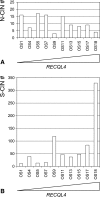Recurrent RECQL4 imbalance and increased gene expression levels are associated with structural chromosomal instability in sporadic osteosarcoma
- PMID: 19242607
- PMCID: PMC2647728
- DOI: 10.1593/neo.81384
Recurrent RECQL4 imbalance and increased gene expression levels are associated with structural chromosomal instability in sporadic osteosarcoma
Abstract
Osteosarcoma (OS) is an aggressive bone tumor with complex abnormal karyotypes and a highly unstable genome, exhibiting both numerical- and structural-chromosomal instability (N- and S-CIN). Chromosomal rearrangements and genomic imbalances affecting 8q24 are frequent in OS. RECQL4 gene maps to this cytoband and encodes a putative helicase involved in the fidelity of DNA replication and repair. This protective genomic function of the protein is relevant because often patients with Rothmund-Thomson syndrome have constitutional mutations of RECQL4 and carry a very high risk of developing OS. To determine the relative level of expression of RECQL4 in OS, 18 sporadic tumors were studied by reverse transcription-polymerase chain reaction. All tumors overexpressed RECQL4 in comparison to control osteoblasts, and fluorescence in situ hybridization analysis of tumor DNA showed that expression levels were strongly copy number-dependent. Relative N- and S-CIN levels were determined by classifying copy number transitions within array comparative genomic hybridization profiles and by enumerating the frequency of break-apart fluorescence in situ hybridization within 8q24 using region-specific and control probes. Although there was no evidence that disruption of 8q24 in OS led to an elevated expression of RECQL4, there was a marked association between increased overall levels of S-CIN, determined by copy number transition frequency and higher levels of RECQL4.
Figures



References
-
- Bridge JA, Nelson M, McComb E, McGuire MH, Rosenthal H, Vergara G, Maale GE, Spanier S, Neff JR. Cytogenetic findings in 73 osteosarcoma specimens and a review of the literature. Cancer Genet Cytogenet. 1997;95:74–87. - PubMed
-
- Zielenska M, Bayani J, Pandita A, Toledo S, Marrano P, Andrade J, Petrilli A, Thorner P, Sorensen P, Squire JA. Comparative genomic hybridization analysis identifies gains of 1p35 approximately p36 and chromosome 19 in osteosarcoma. Cancer Genet Cytogenet. 2001;130:14–21. - PubMed
-
- Squire JA, Pei J, Marrano P, Beheshti B, Bayani J, Lim G, Moldovan L, Zielenska M. High-resolution mapping of amplifications and deletions in pediatric osteosarcoma by use of CGH analysis of cDNA microarrays. Genes Chromosomes Cancer. 2003;38:215–225. - PubMed
-
- Bayani J, Zielenska M, Pandita A, Al-Romaih K, Karaskova J, Harrison K, Bridge JA, Sorensen P, Thorner P, Squire JA. Spectral karyotyping identifies recurrent complex rearrangements of chromosomes 8, 17, and 20 in osteosarcomas. Genes Chromosomes Cancer. 2003;36:7–16. - PubMed
-
- Ozaki T, Neumann T, Wai D, Schafer KL, van Valen F, Lindner N, Scheel C, Bocker W, Winkelmann W, Dockhorn-Dworniczak B, et al. Chromosomal alterations in osteosarcoma cell lines revealed by comparative genomic hybridization and multicolor karyotyping. Cancer Genet Cytogenet. 2003;140:145–152. - PubMed
Publication types
MeSH terms
Substances
LinkOut - more resources
Full Text Sources
Medical
Molecular Biology Databases
